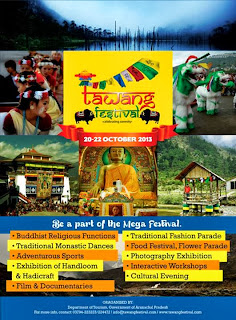DRINKS:
The chief Monpa beverage is butter-tea. In place of normal tea leaves, they use ‘jari’, crude tea leaves. Besides the butter tea, the monpas also brew local alcoholic beverages like Baang- Chang, Sin-Chang, Aarak.
DRESSES:
The Monpas have their own distinctive way of clothing themselves, well adapted to the conditions of their environment. Though they weave most of their essential garments, yet many are imported Kalimpong, Assam, Bhutan. All males throughoutthe district war similar garments with little variation.Two types of trousers are worn by the men. The short trouser is called kangnam and is worn during summer. It is tied round thewaist by a cloth belt. A thick round woolen pad called tengtan is suspended at the rear from the waist. The male shirt is called the Toh-thung. In cold days, a thick woolen cloak dyed red with madder, called Chupa, is worn. It is tied around the waist with a matching sasah called Khichin. Their traditional shoe is called Tsem-lham. Both male and female wear the same kind of boots.The soles are usually of yak or cow hide.
The women wear a dress called Shingka. It is a sleeveless gown of red colour with white stripes. It is lifted and girdled around the waist by a red coloured sash called the Khichin. A square loose sheet of black or red coloured woolen cloth called Teng-nga Kyima is then wrapped at the rear of the waist. The silk shirt is known as the Ellen Toh-Thung, over which is worn another shirt called Kyanchen toh-thung.
The head gear is known as Ngama-shom worn by both men and women.. It has no brim but has five tapering points
ORNAMENTS:
The Monpas have various Ornaments .The names of some ornaments are Son-Dhup (Finger Ring), Nyon-dhup( Bangles), Kaykor (Necklace), Gau ( Silver studded with turquoise), Along ( earring), Grokha( Brooch)
The chief Monpa beverage is butter-tea. In place of normal tea leaves, they use ‘jari’, crude tea leaves. Besides the butter tea, the monpas also brew local alcoholic beverages like Baang- Chang, Sin-Chang, Aarak.
DRESSES:
The Monpas have their own distinctive way of clothing themselves, well adapted to the conditions of their environment. Though they weave most of their essential garments, yet many are imported Kalimpong, Assam, Bhutan. All males throughoutthe district war similar garments with little variation.Two types of trousers are worn by the men. The short trouser is called kangnam and is worn during summer. It is tied round thewaist by a cloth belt. A thick round woolen pad called tengtan is suspended at the rear from the waist. The male shirt is called the Toh-thung. In cold days, a thick woolen cloak dyed red with madder, called Chupa, is worn. It is tied around the waist with a matching sasah called Khichin. Their traditional shoe is called Tsem-lham. Both male and female wear the same kind of boots.The soles are usually of yak or cow hide.
 |
| Dress |
The women wear a dress called Shingka. It is a sleeveless gown of red colour with white stripes. It is lifted and girdled around the waist by a red coloured sash called the Khichin. A square loose sheet of black or red coloured woolen cloth called Teng-nga Kyima is then wrapped at the rear of the waist. The silk shirt is known as the Ellen Toh-Thung, over which is worn another shirt called Kyanchen toh-thung.
The head gear is known as Ngama-shom worn by both men and women.. It has no brim but has five tapering points
ORNAMENTS:
The Monpas have various Ornaments .The names of some ornaments are Son-Dhup (Finger Ring), Nyon-dhup( Bangles), Kaykor (Necklace), Gau ( Silver studded with turquoise), Along ( earring), Grokha( Brooch)
 |
| Ornaments |




































